Saxony is known for sweet dishes, no other German state stands for cakes and pies in such a way. Probably the most famous pastry from Saxony is the Dresdner Stollen. But the country offers even more culinary specialties, from Lusatian linseed oil, to the Vogtland carp, to the changing balls or the well-known Leipziger Allerlei. Not to be forgotten are the Saxon wine and the Leipziger Gose, an old type of beer based on top-fermented brewing.
dishes
- Leipziger Allerlei. It is the most famous dish from Leipzig and is a mixture of young peas, carrots, asparagus and morels. Crayfish are traditionally included, but these days they are often not used.
- Saxon sauerbraten In contrast to the Rhenish sauerbraten, it is without raisins and also not from the horse. A sauerbraten is braised roast, the meat of which is pretreated by marinating in vinegar water with spices for several days. The sauce is bound with a spice cake (sauce gingerbread), which gives the sauerbraten its own note. As a side dish there are dumplings and red cabbage.
- Weigh fried He will be with Cradled prepared, a mixture of pork and minced beef, plus white bread, eggs and spices. The roast is usually served with boiled or fried potatoes and sauce, often with vegetables. In Dresden there is a restaurant "fried as it is" where you can try it.
- Liver sausage In Saxony it is not only eaten as a spread, but also as a main course, for example with jacket potatoes or mashed potatoes and sauerkraut.
- dead grandma In Saxony means grützwurst or crucible sausage, which is freed from the intestines, warmed to a pulpy mass and is typically served with sauerkraut and boiled or boiled potatoes.

Saxon sauerbraten
Dresden Weigh Fried
Liver sausage with sauerkraut and mashed potatoes
- Hunter schnitzel Is a slice of hunting sausage or beer ham, usually one centimeter thick, breaded and served with a sauce made from tomatoes with onions. Potatoes, potato salad, mashed potatoes, French fries, croquettes or pasta are served as a side dish.
Breaded hunting sausage with mashed potatoes and mixed vegetables

Jägerschnitzel made from hunting sausage with tomato sauce and spiral noodles
- Corrugated meat is boiled, uncured pork belly. It is often eaten with sauerkraut and dumpling.
- Teichlmauke, Timplmauke or Titschlmauke, is a dish consisting of mashed potatoes, boiled beef with broth and sauerkraut from the Oberlausitzer Bergland. Chopped meat is placed on a deep plate, mashed potatoes are arranged around the outside so that a hole remains in the middle. This hole represents the pond filled with broth. Finally, sauerkraut is placed around the meat.
.jpg/401px-Wellfleisch_Sauerkraut_Klöße_(1).jpg)
Corrugated meat with sauerkraut and dumpling

Teichelmauke
Soups
- Potato soup The Saxon potato soup is a hearty soup made from squashed potatoes, carrots and celery, seasoned with marjoram. Sausage is often added to the soup.
- Saxon spots are also called Tripe or Beeping designated. It is a vinegar-leavened, lightly thickened soup made from the stomachs of ruminants cut into strips.
- Elderberry soup It is a specialty of linen weavers. She will be on the Oberlausitzer Leinewebertag offered in Seifhennersdorf. But also Vogtland is called Elderberry soup eaten.

Saxon potato soup with sausages

Saxon spots
elderberry soup
Potatoes
- Dumplings are a variant of the potato dumpling. The rolled out dumpling dough with flour and egg is sprinkled with fried breadcrumbs and wrapped. Then the roll is cut to the size of a dumpling and the dumplings are then cooked in boiling water.
- In West Saxony roll dumplings are made from the same dough as dumplings, except that the dough is rolled out wider. The flat dumpling dough is coated with butter and sprinkled with browned breadcrumbs. Then the dough is rolled up and cut into 10-15 cm pieces. These dumplings are then cooked for 15-20 minutes and then served with sauerbraten or roulades.
- in the Ore Mountains potatoes are first boiled in their skins and only peeled when they are cold. The grated or pressed potatoes are kneaded with egg and flour to form a dough and seasoned with salt and nutmeg. The dough is rolled out as thin as a pencil, coated with butter and breadcrumbs as already described and then rolled. Finally cut into pieces, the ends are squeezed together and then cooked. The dumplings are eaten with stews such as goulash or roast rabbit.
- Stubberle, or Bump is a variant of the potato dumplings in the Upper Lusatia

Upper Lusatian Stubberle
- As Bambes will be in Vogtland called the potato pancakes.
- Grimaces. are a type of potato pancakes from the Ore Mountains. Raw or boiled potatoes are grated and seared on both sides as palm-sized flatbreads. If they only consist of raw potatoes, they will Griene grin called.
- Klitscher. are another type of potato pancakes from the Ore Mountains. The dough contains egg and onions, quark, buttermilk, sauerkraut or caraway seeds can also be added. They are often served with sweet side dishes, but also with lamb's lettuce (ore: Rawinzeln) eaten. With boiled potatoes they are called Golden Klitscher, with raw potatoes Green Klitscher. If they contain sauerkraut, they are called Sour Klitscher.
- Rauchemaad. are another kind of potato pancakes from the Ore Mountains where only boiled potatoes are used. The dough is pressed into a pan as thick as a thumb and only seared on one side. They are sprinkled with sugar and eaten warm. As a side dish, there is apple sauce or berry compote.
- Mountain pines are another type of potato pancakes from the Ore Mountains
Bambes with applesauce

Rauchemaad
- Getzen. , or Buttermilk Getzen are a traditional dish from the Ore Mountains. They consist of grated raw potatoes, buttermilk, diced bacon and onion, are seasoned with pepper or caraway seeds and sometimes topped with bacon or fried sausage pieces and baked in a pan with linseed oil. Berry compote is usually served with it.
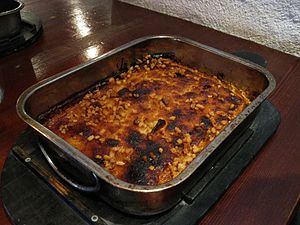
Buttermilk gauzes
fish
Trout
They are often floured as trout Miller or blue with boiled potatoes or smoked.
carp
They mostly will blue offered in vinegar stock with root vegetables and creamed horseradish. The Christmas carp is very popular at Christmas.
- The Vogtland carp is eaten with red cabbage and boiled potatoes or with green dumplings. The sauce consists of carrots, parsley root, kohlrabi, poree, beetroot, celery and bread crust, seasoned with peppercorns and bay leaves. It is boiled in a separate saucepan and then mashed. Layer the salted carp pieces with butter in a saucepan and pour the sauce over them. After a cooking time of 45 minutes, the dish is ready to serve.
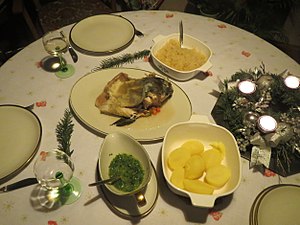
Christmas carp
Pastries
Saxony is a paradise for lovers of sweet food. No German state stands for cakes and pies like that - Gaffee and Guchn is for many Coffee Saxons a necessary meal.
- Cottage cheese are fried dumplings made from a potato and quark dough with raisins, sugar and cinnamon.
Quark legs
- A (Dresden) egg pancake is a three-layer sheet cake (but it is also available as a cake - the taste is the same). First a thin base made of yeast dough, then a layer of quark pudding in the middle and on top a broad layer of fluffy egg yolk cream. Raisins and / or crumble sugar can be included, but are not necessarily one of them. The Dresden-born writer Erich Kästner wrote about it: "The egg pancake is a type of cake that has remained unknown to the rest of the world to the detriment of humanity." The word Check Incidentally, has nothing to do with snails or piebald animals, but is probably derived from a medieval piece of clothing (see English jacket), which was worn with a wide belt and therefore also had three stripes.
- The Freiberg egg pancake In contrast to the Dresden variant, it does not have a quark layer (according to legend, it was developed when all the quark available in the city had to be used to build or repair the Freiberg city wall). The sweet ice cream with raisins comes straight to the bottom.
- sweet cake is another regional cake specialty from Saxony and Silesia. It consists of puff pastry that is glazed, coated with jam and covered with a thick layer of crumble. There are different variants, including with fruit, icing, chocolate icing or cinnamon sugar.
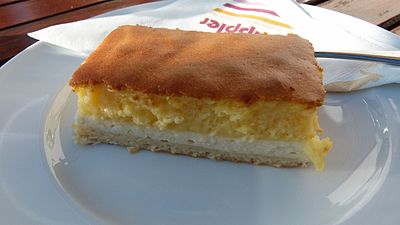
Dresden egg pancake
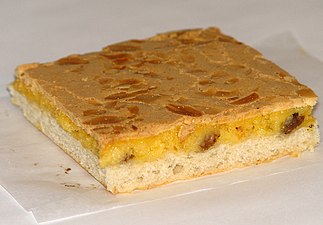
Freiberg egg pancake
Pretzel cake with icing
- A Leipzig Lark is a small shortcrust cake filled with marzipan. Its shape is reminiscent of hearty pies with real lark meat, which used to be served on festive days. The hunt for the songbirds was banned in 1876 and so the Leipzig confectioners invented a sweet substitute.
- At a Leipziger Räbchen A pitted prune is filled with marzipan, turned in beer batter and fried in hot oil. The Räbchen are found in a few traditional restaurants in Leipzig, such as B. in the coffee house To the Arabian Coffe Tree or Café Kandler offered and eaten hot there.
- Meissner fumble. is a balloon-shaped hollow body made of very thin, simple pasta dough and is brittle and fragile. The pastry consists of flour, water, fat, sugar and salt and has a rather subtle taste. The fumble is eaten with coffee or wine. According to legend, August the Strong is said to have given the Saxon couriers who were transporting the Meissen porcelain fummels to check how carefully they rode. If the fumbles remained intact, the china was also intact.
- In the 1 Zieger pastry shop in Meissen you can try the Meißner Fummel. You could try whether you could bring it home in one piece, the Fummel cannot be shipped.
Leipzig Lark

Leipziger Räbchen
.jpg/338px-Meißner_Fummel_(02).jpg)
Meissner fumble
- Probably the most famous Christmas specialty from Saxony is the Dresdner Stollen. As a product with a protected geographical indication, it may only be manufactured in the Dresden area. Dresdner Stollen must not be baked in molds. The composition is also fixed: at least 50 parts butter, 65 parts raisins, 20 parts lemon peel and / or orange peel and 15 parts almonds must be added to 100 parts of flour. Artificial preservatives and flavors or even margarine are not allowed. In other parts of Saxony there are also tunnels (depending on the region it is called the Stollen or the Stolle) baked, which differ only slightly from the Dresden original.
- Pulsnitzer gingerbread. are handcrafted gingerbread cookies whose basic dough has matured longer before baking. You will be in the region around Pulsnitz Offered all year round, not just before Christmas.
- The 1 Pulsnitz gingerbread museum, Am Markt 3, 01896 Pulsnitz. Tel.: 49 35955 44246. shows the history of gingerbread, production, historical machines, cookie cutters, models, tins and much more. Guided tour and tasting from 10 people.Open: Tue to Sun 10:00 a.m. - 4:00 p.m., December 24th. until 01.01. closed.Price: adults € 3, children € 1.50, free for children under 6.

Dresdner Stollen

poppy seed stollen
Pulsnitzer gingerbread
Sweets
ingredients
- Lusatian linseed oil is a protected designation of origin. A Lusatian specialty is dipping rolls in linseed oil and sugar, or eating jacket potatoes with quark and linseed oil.

Rolls with linseed oil and sugar
.jpg/316px-Quarkmitleinölundpellkartoffeln3_(cut_out).jpg)
Jacket potatoes with quark and linseed oil
- Bautz'ner mustard is known far beyond the Bautzen region. He gives the variants medium hot and hot
- in the 1 Bautz'ner mustard shop, manufactory & museum the history of Bautz'ner mustard is shown in several showcases and there is a mustard mill from the last century. You can also try and buy mustard.

Bautz'ner mustard medium hot
- Push-back cheese is a special cooked cheese from the Erzgebirge, which is made from Harz cheese, cream or butter, beer, salt, pepper and caraway.
- in the 2 Mountain inn Riesenbergerin Eibenstock you can try the Schiebböcker cheese.
beverages
Wine
With less than 500 hectares, the wine-growing region of Saxony is one of the smallest wine-growing regions in Germany. This also includes vineyards in Saxony-Anhalt and Brandenburg. It stretches along the Elbe from Pirna downstream to around the wine villages Diesbar-Seusslitz. Mainly white grape varieties are grown, some sparkling wine is produced, and a few areas are planted with red wine varieties.
The Gold Riesling is a white wine variety that is only grown to a significant extent in Saxony.
The Saxon cone is a wine bottle with a special shape that is only used in the Saxon wine-growing region.
The winery Wackerbarth Castle in Radebeul produces sparkling wine using classic bottle fermentation, the same method that is also used for champagne.
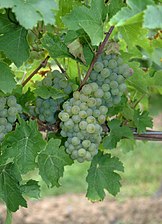
Gold Riesling grapes

The council vineyard in Weinböhla
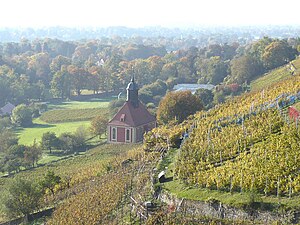
Vineyards and vineyard church near Pillnitz

A club of saxons
beer
- Leipzig Gose is an old type of beer based on top-fermented brewing, where, in addition to alcoholic fermentation, another, bacterial lactic acid fermentation takes place. That is why it has the typical sour taste, similar to that of the Berliner Weisse. Another specialty is the addition of salt and coriander. In Leipzig Gose is brewed again according to the old recipe. You can drink them in the Gosenschenke without hesitation, or with our own Gosebrauerei im Bavarian train station. But it can also be found on the menu in other inns in and around Leipzig.
- You can drink the sparkling beer neat, right?
- with syrup red or green
- with cherry liqueur
- with a caraway liqueur
- with Curacao
- with banana or strawberry juice.
.jpg/150px-Die_Gose!_(5595755232).jpg)
Leipzig Gose

Leipzig Gose bottle
Overall, Saxony can be described as a beer country. In addition to standard Pilsners like Radeberger (Dresden area), Wernes green (Vogtland), Freiberger, Star source (Plauen), Ur-Krostitzer (Leipzig area), hermit (Chemnitz) or Landskron (Görlitz) and the cheap brand Sternburg export from Leipzig, there are also a number of smaller breweries with their own beer creations, e.g. B. Meissner swords, Brewing pride from Chemnitz, the Blechschmidt private brewery from Treuen in Vogtland with theirs Faithful goat or the Zwönitz brewery in the Ore Mountains with the red-blond one Feieromd beer.
Schnapps and liqueurs
- Allasch caraway liqueur
- Reudnitzer black beer liqueur with 20% alcohol
- The Dresden Stollen Liqueur is only available during the Christmas season.
Soft drinks
- Juice from numerous local cider factories, preferably from Orchards
Culinary calendar
Culinary delights are often seasonal. Fruits and vegetables are tastier when they are ripe; meat and fish are also subject to seasonal influences. Every season of the year, festivals are celebrated that have a general theme or focus on certain foods. There are also drinking and eating habits throughout the year that arose from religious traditions such as fasting times.
January
February
March
- The third Sunday in March will be in Seifhennersdorf in the Upper Lusatia the Oberlausitzer Leinewebertag celebrated with the specialty elderberry soup
April
- The Asparagus season starts at the beginning of April, depending on the soil temperature
- Traditionally on April 23rd the Day of the beer celebrated, because on this day in 1516 the German purity law was proclaimed. There are events on the topic of beer in many places (German Brewers Association).
May
- Asparagus season
June
- The Asparagus season ends on Midsummer Day, June 24th.
- This takes place from mid-June to mid-July Upper Lusatian Gourmet Festival instead of. A variety of restaurants in the region offer Bump (Dumplings) with bacon and sauerkraut.
July
- This takes place from mid-June to mid-July Upper Lusatian Gourmet Festival instead of. A variety of restaurants in the region offer Bump (Dumplings) with bacon and sauerkraut.
August
September
- Wine festivals are held on various weekends in the wine-growing regions in Radebeul, Meissen, Coswig etc. celebrated.
October
- Horstseefischen in Wermsdorf. Celebratory carp fishing with the election of the fish queen. Usually the second weekend in October.
November
December
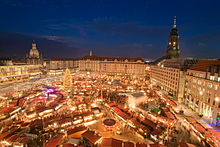
- Since 1434, the Dresden Striezelmarkt hosted. He is known for Dresden stollen, gingerbread and plum tomato.
- This takes place on the Saturday before the 2nd Advent Dresden Stollen Festival instead of. A giant stollen weighing around 4 tons is baked and there is the "Stollen Procession", a parade of Dresden pastry chefs and bakers.
literature
- : Culinary tours through Saxony's villages. Saxo'Phon GmbH, 2018, ISBN 9783943444735 , P. 184. Through all regions of Saxony
Recipes
If you feel like enjoying Saxon cuisine at home, you will find the appropriate recipes in Koch Wiki under Category: Saxon cuisine. Have fun cooking at home.










.jpg/401px-Wellfleisch_Sauerkraut_Klöße_(1).jpg)
















.jpg/350px-Meißner_Fummel_(02).jpg)


.jpg/338px-Meißner_Fummel_(02).jpg)




.jpg/316px-Quarkmitleinölundpellkartoffeln3_(cut_out).jpg)





.jpg/150px-Die_Gose!_(5595755232).jpg)

